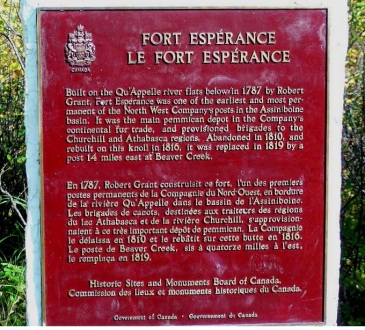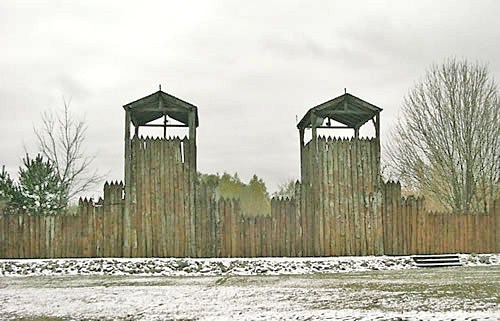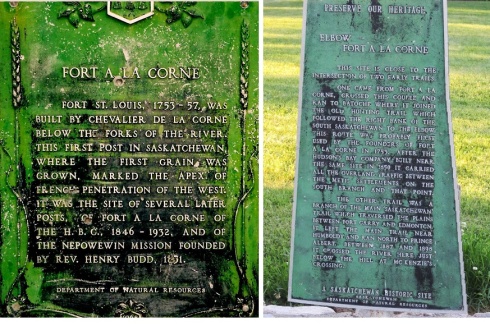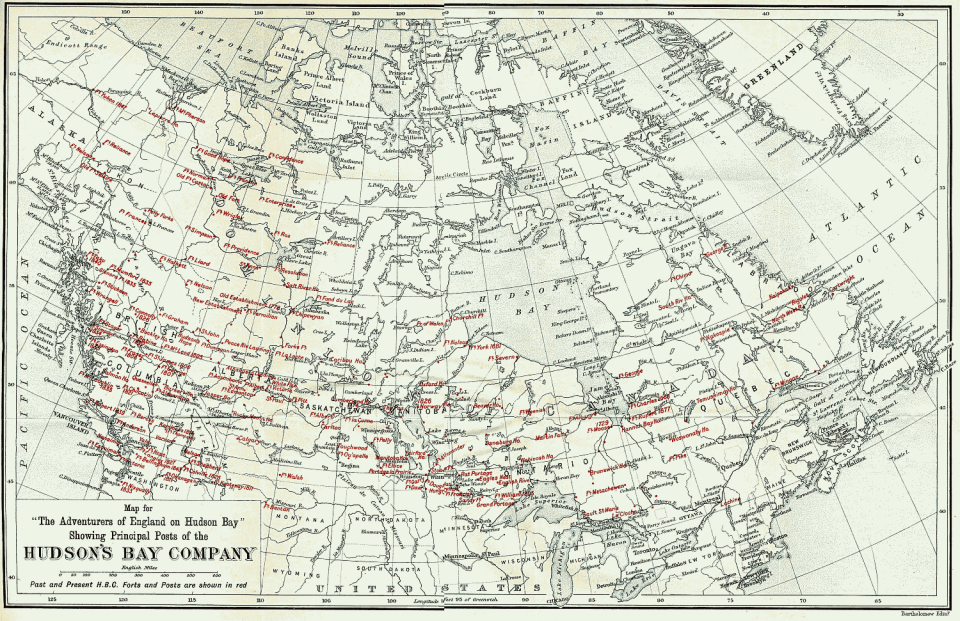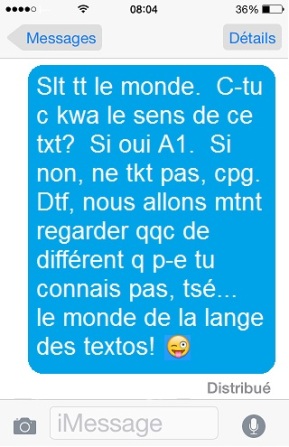Home » Posts tagged 'French' (Page 2)
Tag Archives: French
The Quebec Board of the French Language (#337)
If you are from Québec, if you are Francophone elsewhere in Canada, or if you have studied French to any of the advanced levels in Canada, the chances are very likely that you are well aware of the Québec Board of the French Language.
The French name is the Office québécois de la langue française (OQLF).
In media circles, the OQLF is sometimes known by it’s sensationalized nick-name,“the language police”. In my opinion, such a nickname is a bit “unfair”, and you’ll soon see why.
The OQLF is a provincial government agency, and has had a mission since the mid-1960s to counter a degradation of the quality of French used in day-to-day life.
I’ll give you the perfect example of what I mean.
In some of the French videos I made myself for this blog (here and here for example), you’ll notice I have a little “habit” of slipping in the English word “anyway” into French sentences (as do many Francophones in Québec and around Canada). “Anyway” has become almost part of casual, colloquial everyday vocabulary.
Letting slip the odd little English word from time-to-time certainly is not the end of the world, nor should it be considered the end of the world. In such cases, it is as natural to do so in French as it is to say “Rendez-vous”, “resumé” (instead of C.V.), or “déjà vu” in English. Everyone does it (however, in French, I probably say “alors” or “bon” much more than I say “anyway” – since they are the French equivalents).
Yet, from what I’m told, the situation of inserting English words into English used to be much worse 55 years ago at the time the OQLF was founded. It was so bad in fact, that it was feared that French in Québec (and in Canada) would soon reach a point of no return in the sense that there were fears it could morph into a new dialect – a hybrid French/English dialect.
Don’t get me wrong, we were not at the point of French not becoming some strange new way of speaking, but things looked like they could have eventually gone in that direction if there was not an organization to concentrate on the the public quality of French used.
The OQLF’s mission was simply to prevent this from happening, and to “support and encourage” the use of proper French in spheres where French was expected to be used.
This meant the OQLF’s role was to reinforce language quality and use in institutionalized settings, such as schools, hospitals, government offices, and areas of life regulated by government regulations.
And the efforts seem to have paid off.
The OQLF cannot tell you what you can or cannot verbally say (that would not be cool! – and it would be highly illegal). But they can encourage you to use proper French in institutionalized settings – and hey, why not? I’m game!
The bureau does so by providing resources and tools (such as one of the best and most comprehensive online French and French-English dictionaries in the world), public reminders, and assistance to individuals and enterprises who are working in French-language settings.
This is why, right from the beginning, in schools students know what correct terms to use, and society’s general quality and use of French has been enhanced.
This is also why, on an “institutionalized” or “formalized” level, French in Canada does not use anglicisms (or relatively very few) in higher level French (ie: in advertisements, in government or formal publications, etc).
Quite surprisingly, France does find it acceptable to use English words in formal settings and publications.
At an institutionalized level, you will find in France, one will use “weekend”, “email”, “shopping”, “parking”, etc.
However, in Québec, and Canada (as a result of guidance from the OQLF), we say “fin de semaine”, “couriel”, “magasinage”, and “stationnement”.
(Note: The OQLF’s influence is felt elsewhere in Canada as well. Thus Francophones and those learning French in other provinces also look to the OQLF’s guidance, and thus it has influence and a “standardizing” effect across the country – not just in Québec).
For lack of a better term, the OQLF is the “public promoter for the correct use and implication of French in the public sphere”. The “public sphere” is different than the “private sphere”. But of course there is a natural a spill-over effect from the public sector to the private sector (hence why I probably subconsciously say “alors” much more often than “anyway” when I’m having informal, private conversations with friends).
So as you can see, the OQLF is not some baton-waving cop who is foaming at the mouth to beat you over the head. They simply are a great resource and public reminder for ways in which to properly speak and use French.
But…
Where the OQLF does derive its nickname “the language police” is from the agency’s “active involvement” in public signage and workplace language of administration (applicable to companies over a certain size or which deal with the public). Québec has a law which states that French much be the dominant signage in the public sphere (while allowing English to also appear, but at half the size of French). If there is breach in the law, the OQLF is the agency mandated to deal with it. The OQLF will issue guidance, then warnings, then in very rare cases, a possible fine.
Again, such cases are very rare, and this is only one part of the OQLF’s overall mission. But when it happens, the person on the receiving end sometimes gets their nose very out of joint, makes a huge deal of it, gets the media involved, and the whole thing blows up.
That’s not to say that the OQLF hasn’t been a little overzealous on occasion also. You may recall a couple of years ago, a rogue employee at the OQLF told someone they could not use the word “pasta” on their menu because it is not a “French” word. Well, if that didn’t blow up like a nuclear test in the South Pacific!! After a huge public backlash, I think some heads probably rolled at some level within the OQLF.
Fortunately, such cases are very few and far between. Most people in Québec still view the OQLF in their role as a positve resource and language-support agency rather than in their capacity as a workplace-enforcement agency (yet elsewhere in Canada, it is only the latter which disproportionately and unfairly gets all the attention).
Check out the OQLF’s online resources. They are comprehensive, informative, and well organized.
- Main page: http://www.oqlf.gouv.qc.ca/accueil.aspx
- The main French, and French-English dictionary : http://gdt.oqlf.gouv.qc.ca/
- A great tool for how to use French words correctly (with example sentences): http://www.oqlf.gouv.qc.ca/ressources/bdl.html
Québec’s “surprise” album (and singer) of the summer (#335)
Almost a year ago, I wrote a post entitled Country music = Québec.
In that post, I explained how Québec’s music roots have always been connected to a genre of French-language country music.
A couple of people I know (who are from Montréal) said I was nuts when I wrote that post. They told me nobody listens to (French) country music (or any country music). My response: “Perhaps you’re right if you live downtown Montréal, and if you base your entire life around downtown Montréal”.
I told them to just wait for a few months, perhaps a year or so. I told them with the uptick in French-language country singers and it’s resonance / ties with traditional French Canadian music, that I would bet my bottom dollar that we’d see a virtually unknown French-language country artist come to the fore and top the album charts in Québec.
They thought I was crazy…
Well… the writing was on the wall — and guess what! It just happened!
The reality (in Québec an elsewhere) is that
- many people in Québec listen to French-language country music, and
- there can often be a HUGE disconnect between our largest cities and all the rest. You get the sense that this disconnect becomes as wide as the Pacific when it comes to lifestyles and concerns lived by people who reside in the downtown cores of our larger cities, and all the rest (even the suburbs for that matter).
As usual, the rest of Québec, and the rest of Canada do not all live in downtown Montréal, Toronto, or Vancouver (on that note, one federal party leader in particular better learn this little factoid very fast, or his party will be heading straight down the tubes in October – ok, ok… no more political commentaries, I’ll behave now).
This post will make my point, and will emphasize just how wide that gulf can be (between the city – particularly the city cores — and all the rest).
Guylaine Tanguay is a French-language country singer, from the Saguenay region in Québec – particularly from Dolbeau (I actually wrote a post on her hometown last winter, which you can read by clicking HERE… (Boy… even I am surprised that I wrote a post on Dolbeau! I guess I have covered some territory with his blog after all).
Her new album, Inspiration, was one of the best-selling albums in Québec of the entire summer!
Yet, ask someone in Montréal (particularly downtown Montréal), or downtown Québec City, or downtown Ottawa (which I consider within the “Québec urban sphere of influence”) who she is, and you’ll just get blank stares.
But go elsewhere, such as the smaller cities around the province, and you’ll find a good deal of people who know who she is (you don’t even have to go very far… sometimes just as far as the suburbs such as St-Eustache, Gatineau, or Beauport).
Her fifth country music album, Inspiration Country, came out on June 16th,
All Tanguay has done was a little advertising on television, given a few concerts, and the crowds AND SALES came’a flock’in!
Here is the TV advertisement for her latest album:
Province-wide, her album has even bumped out the “Clique’s Montréal’s downtown darlings”, such as Jean Leloup and Yoan, from the top spots.
This little whirlwind named Guylaine Tanguay has the (sometimes quite stuffy) “downtown Montréal cultural class” (informally known as the “Clique du Plateau”) scratching their heads in disbelief (and me shaking my head at their disconnect from the rest of the province). I actually wrote a post on the Clique du Plateau way back when (click the link).
Whether or not you think a true media Clique exists (ie: media which all beats the same drum in central Montréal), is a question of debate, impressions, and person viewpoints. Regardless of my own viewpoints, it’s not for me to categorically say if it does or doesn’t exist (there are people with opinions all over the place, and grey comes in all shades).
However, if the Clique were to describe a general “downtown attitude” in any big city, then you could perhaps say it’s a snobby attitude, in the sense that if related media feels “their own” media circles were not the ones to launch or promote someone’s career, or if “they” were not the ones to invite an artist to their TV or downtown radio programs, then it the music must be crap (sigh x 10).
Guylaine Tanguay is one person who could be said to have proved them wrong – and in no small way.
You can check out her website at http://www.guylainetanguay.ca/
Here is an article by a “shocked” and baffled Radio-Canada (hahaha!! Love it!!!) — Click HERE.
Here is an article by the Courier de Laval (from the suburbs of Montréal, so it comes with less shock and horror than articles written from downtown Montréal – hahaha!!!). Click HERE.
You can purchase her hit album online at Archambeault at the following link: http://boutique.archambault.ca/divertissement/Guylaine-Tanguay
If you wish to purchase single songs off her album (on platforms such as iTunes), they are
- Jusqu’au bout du monde
- Colinda
- Crazy Arms / Dans tes brasIsland In the Stream (avec Mario Pelchat)
- Thank God I’m a Country Girl
- Je voudrais être Madelinot
- Que la lune est belle ce soir (avec Julie Daraîche)
- Me and Bobby McGee
- La fête en AcadieCrazy
- Je voudrais voir la mer (avec Michel Rivard)
- Embarque ma belle (avec Christian-Marc Gendron)
- You Are My Sunshine (avec Camille Tanguay)
P.S. Although my roots are from rural areas (I’m just as comfortable in a pair of shit-kickers as I am sneakers), I have nonetheless lived in some of the largest cities around the world and Canada. I certainly like many aspects of the larger city “downtown” lifestyles (otherwise I wouldn’t live on a subway line with a direct connection downtown). But as you can see from the above post, sometimes the snobby “downtown attitude” irks me. I have spent a LOT of time in and around Montréal’s downtown. It’s where many friends live. But like any city, Montréal’s downtown core also has its fair share of this attitude I’m referring to. Yet, like anything in life, you take the good with the bad – and there is still far more good than bad 🙂
Two “mystery forts” tied to Québec’s role in founding Alberta and Western Canada (#330)
(Click any image below to enlarge)
Prior to Britain’s control over all of what was to become British Canada (in the run up to confederation and independence), much of what was New France was governed by administrators based in Québec City and Montréal.
It is well known that the reach of New France extended from Labrador in the North, to New Orleans in the South.
But surprisingly, today, what were the “westernmost” reaches of New France rarely receive attention in the media or elsewhere outside of the Prairies (especially in Québec itself). It is a history which is better known to students from Western Canada than to those elsewhere (much of this history is mandatory learning material for high school students in the Prairie provinces).
When I first moved to Eastern Canada way back when, I was surprised (even shocked) to learn that very few people in Eastern Canada knew anything about the pre-British, pre-1763 New France influence throughout Manitoba, into the heart of Saskatchewan, and even into Alberta.
Coming from Alberta and having lived in all four Western Provinces, at the time I simply took it for granted that was a part of history which everyone everywhere knew about.
Funny how it is “Louisiana” which primarily manages to disproportionately steal everyone else’s thunder garner so much attention when it comes to talking about the “far-reaches” of New France and subsequent turns-of-events… but whatever… damned Cajuns, Zachary Richard & Louisiana!!! I suppose Louisiana is cool too 🙂
As an aside, I believe it was from the New France era that the word “Soyeu” became part of Prairie French in Western Canada, and particularly Albertan/Saskatchewan French. It’s an old word from Old Picard and old Wallon French which literally means to saw something in half… ie: “Wednesday” (which saws the week in half).
In Québec and Ontario, the closest might be the French expression “nombil de la semaine”, but “soyeu” is more of a direct translation for “Wednesday” than it is an expression.
When I moved to Québec at the beginning of the 2000s, I told a friend that I would call her on “Soyeu”. It was only when I saw the look her face that I realized that nobody outside of Western Canada knew what “soyeu” meant… Lundi, mardi, “soyeu“, jeudi, vendredi, samedi, dimanche — NOPE… just blank stares in both Québec and Ontario.
Nowdays, young Francophones in Alberta generally just say mercredi. However it is still interesting to know that there continues to be somewhat of a direct New France influence on Prairie French.
At least two French forts (and possibly two others) were built in Saskatchewan in the 1750s.
(The HBC established their own “Fort Espérance” after the British hand-over, but it is speculated that a New France fort existed at the same site in Saskatchewan much earlier)
At least one French fort (Fort la Biche) and possibly one other (Fort la Jonquière) were built in Alberta in the 1750s.
After the change of administration from New France to British North America, many of the forts in Western Canada continued to be administered by Francophone-ran trading companies, mostly as trading outposts (with an administration based in Montréal).
Others were converted to new regime military installations.
Yet others were abandoned.
Some have been restored and exist as museums today.
(ABOVE: Restored Ft. Rouge)
(ABOVE: Restored Fort Bas de la Rivière)
Some New France-era forts have since become major urban centres or modern-day communities. For example:
- Fort Rouge became Winnipeg,
- Fort Dauphin became Dauphin (MB),
- Fort la Reine became Portage La Prairie (MB).
Of those forts which were abandoned, their locations are generally known, and markers have been placed where they once stood (such as the case for Fort Bourbon II, Fort à La Corne, or Fort Maurepas II). Yet many (perhaps most) have not undergone archaeological excavation (a fact which completely baffles me – but which could mean that many new and exciting discoveries are yet to come).
Of all the New France-era forts, the location of Fort à La Corne (in Saskatchewan) is the westernmost confirmed location. It was also the first place grain was grown in Western Canada. Its exact location was on an unstable sandy spit of land on the banks of the confluence of the North and South Saskatchewan Rivers. The spit of land was presumably washed away generations ago, and the earthen cliffs above the land began to fall into the river in 2009. The road and the trails leading to the exact location have now been closed.
For all you Google Streetview enthusiasts, you can view the viewpoint above the site by clicking here: https://www.google.ca/maps/@53.233378,-105.086365,3a,66.8y,44.32h,86.78t/data=!3m4!1e1!3m2!1sIubHklZaehf7EkWsfM19wg!2e0?hl=en
Fort La Biche and Fort la Jonquière
Yet there were two forts further West of Fort à La Corne, and their locations remain mysteries. I find it surprising that the fate, location, and historic roles of these two westernmost forts do continue to remain a major mystery.
Fort La Biche on the “La Biche River” in Alberta (the “Red Deer River” in English) was established at an unknown location. Many speculate it was actually established on or near the actual site of Red Deer Alberta, but I have not seen any proof that Red Deer was the actual location. The internet is almost silent on the issue (offering no proof of location).
The location of Fort La Jonquière also remains a mystery, but one with a potentially more exciting story, and perhaps a much more significant role in history.
There are four suspected locations for Fort La Jonquière:
- Prince Albert, Saskatchewan,
- Edmonton, Alberta
- Calgary, Alberta (within view of the Rocky Mountains)
- There is a 4th possibility that it could have also been built in the Foothills of the Rocky Mountains, meaning that the men of Pierre Gaultier de Varennes et de La Vérendrye would have been the first Europeans to have seen and possibly set foot in the Rocky Mountains.
With the exception of Fort La Biche (Alberta), Fort La Jonquière could have been the westernmost post of the French Empire.
Furthermore, if it was located at Edmonton or Calgary, it would have begun a trading tradition with the local aboriginals which possibly could have given rise to later decisions by British explorers and trading companies to establish more modern forts at the same locations (such as Fort Edmonton, which has since become the major Canadian city of Edmonton and the capital of Alberta).
In fact, some have speculated that Fort La Jonquière could have possibly been on or near the site of actual Fort Edmonton (now the site of the Alberta legislature – the seat of Alberta’s provincial government).
(ABOVE: A photo between 1905 and 1912 in Edmonton, with the Alberta provincial legislative (government) building in the background, and Fort Edmonton in the foreground — possibly the original site of Fort La Jonquière).
Considering the impact these Québec-administered forts have had in founding Western Canada, I find it amazing that the story, locations, and relevance of two of the most historically significant forts (Fort La Biche and Fort Jonquière) remain a mystery to this day – especially if they were instigating factors in spurring trade, which subsequently lead to later decisions to found Edmonton or Calgary.
———————
Some info for additional reading: following the change of administration from New France to British North America, the Hudson’s Bay Company became the de facto government of what was Western and Northern Canada. It quickly established dozens and dozens of subsequent forts across the land. Yet many (perhaps most) continued to be Francophone-administered (despite being under British control).
This was a major reason why French continued to be Western Canada’s primary language until the last half of the 1800s (and even into the 20th century in many communities — a legacy of much of Western Canada’s current French regions).
Here is a link for the HBC forts: https://en.wikipedia.org/wiki/List_of_Hudson%27s_Bay_Company_trading_posts
Here is the only open-source map I could find of the HBC forts (although it’s not very good):
————————————
P.S…
If Fort La Jonquière does turn out to be the original foundations of Edmonton… why couldn’t they have found some place warmer, like Florida, or Singapore !?!?!
But at least there’s no or little humidity in the Western part of the Prairies. I’ve never found the winters there much colder than Toronto, Ottawa, Montréal or Québec City (where it is quite humid). -25 degrees Celsius with no humidity in the Prairies = -10 degrees in Toronto / Montréal with humidity.
Anyway, we can see the New France heritage to this day in the Prairies. For example, there are those in Edmonton who still keep those ‘ole Prairie Voyageur traditions alive and well (Alberta through-and-through)…
And also in Winnipeg…
You’ll even find French advertising in the Prairies if you look for it (here is an example)…
But fancy new trains don’t mean that it’s all urban-urban.
Here’s the part of the West’s traditions which I can identify with from my own youth — and it started in no small part with the legacy of our New France heritage back in the 1700s…
Even in the most conservative and Anglophone regions of Canada (such as inAlberta’s deep rural South, in the small town of Brooks), we continue to see the legacy of New France’s Prairie. Almost 300 years later, it continues to make in-roads at all levels of government.
These are points of pride for people on the Prairies (both Anglophones and Francophones) — otherwise we wouldn’t be seeing such gestures such as the one you’re about to see at City Hall in Brooks.
La Franco-Fête de Toronto – la version torontoise des Francopholies (#309)
ADDENDUM 30-07-2015
Usually I add addendums at the end of blog posts, but owing to the significance of this one, I’ll it at the front. By the end of this years Franco-fête in Toronto over the course of two weeks, 100 concerts took place with over 350 singers. Estimates were that between 700,000 and 1,000,000 (million) people attended the concerts in Dundas Square at one point or another. HUGE SUCCESS!
D’habitude j’ajoute des addendum à la fin des billets… Mais compte tenu du succès de la Franco-fête cette année, je le crois une bonne idée de mettre cet addendum en haut du billet. Durant les deux semaines de la Franco-fête, plus de 100 concerts ont eu lieu avec plus de 350 chanteurs participants dans la place Dundas à Toronto. Les organisateurs croient qu’entre 700,000 et 1,000,000 (million) personnes l’ont assisté les concerts à un moment ou à un autre. Un ÉNORME SUCCÈS!
I’m inserting a quick post about an event that is going on right now in Toronto (this will be of interest to followers in South-Central Ontario).
Franco-Fête is the Toronto equivalent of Les Francofolies de Montréal outdoor concert week (click here for last years’ post on Les Francofolies).
Along with la Fête Franco-Ontarienne in Ottawa, FRANCO-FÊTE is one of the larger French-language concert weeks in Ontario. This is my first year attending it, and there is no shortage of events!!
The main concerts are being held in downtown Toronto at Dundas Square, in addition to other venues all around the city.
Franco-Fête is going on right now. Some of the big names, from various provinces this year are
- Arianne Moffatt
- Radio Radio
- Swing
- Zachary Richard
- Lisa Leblanc
- Kevin Parent
- Louis-Jean Cormier
A good number of well-known Franco-Ontariens are also being featured, such as
- Mélanie Brulée
- Les Chiclettes
- Yao
- Stef Paquette
And there are many many others!
You can find the complete concert and event listings at
http://www.franco-fete.ca/
Last night some friends and I checked out the concert given by the popular Acadian group Radio Radio.


